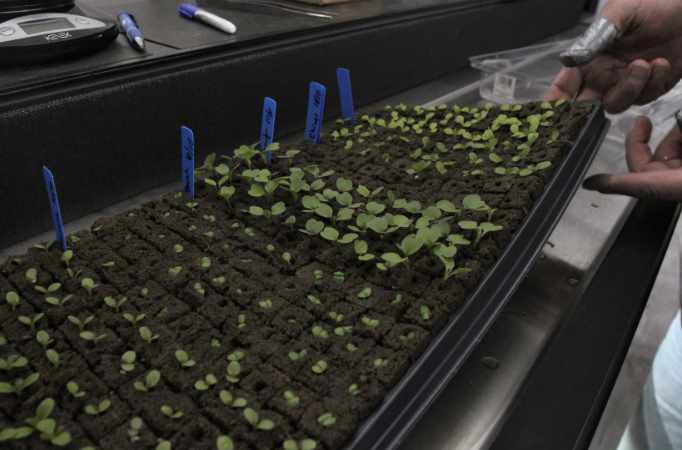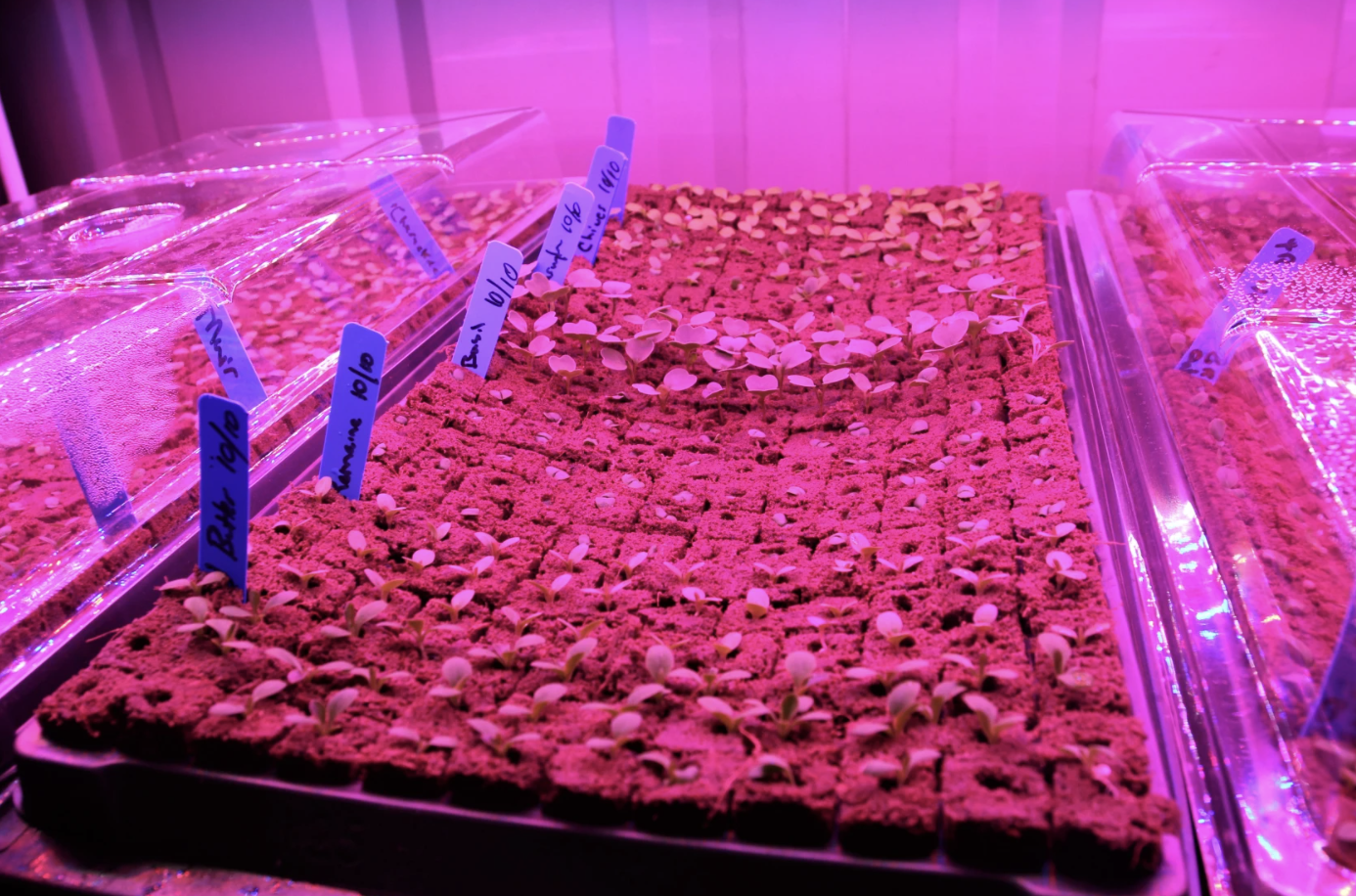USA: Minnesota - Four Acres In A Box: Wykoff Couple Venture Into Vertical Hydroponic Farming
The Rahes plan on selling lettuce, microgreens, and herbs to individuals and restaurants around Southeast Minnesota and northeast Iowa.
October 21, 2022
WYKOFF — In his high-tech cargo container behind Wykoff's Minnwest Bank branch, Tony Rahe takes a tray of greens off a nursery shelf and places it on a counter. The tray and its clear lid, used to keep humidity in while the plants emerge and grow, look somewhat like casserole pans. In a few weeks, those green sprouts will become food.
"I have six types of lettuces," Tony said. "I got summer crisp, we got Romaine, oak leaf and a purple leaf, and a red butter and a green butter. And then I got some arugula, basil and chives."
Over the past two weeks, Tony and his wife, Kelly Rahe, have planted their initial crop on Rahe of Sunshine Farms , which is entirely contained in a 40-by-8-foot cargo container-turned-hydroponic grow lab from Freight Farms . They plan to harvest their first crop by the end of the year.
"You can grow about 4 acres of crop in eight weeks," Tony said. "That's a lot of crop."
The couple intend to sell their produce year-round, thanks to the farm's climate-control system, and offer their greens to individuals and restaurants through their website, area farmers markets and a soon-to-be-built farm stand in Wykoff. For online sales, Rahe of Sunshine Farms uses a website called Barn2Door . Through that, Tony said, people will be able to place orders and pick them up at a designated pick-up point a few days later.
"I'll do that in Rochester, Owatonna, Decorah, LaCrosse, thinking maybe even Austin," Tony said.
The goal: Provide fresher produce for Minnesotans and Iowans through a vertical hydroponic farm that uses minimal water and no soil.
"By the time you get it in through a distributor, you have a couple of days to use up the product, or it's bad," Kelly said of conventional produce operations. "(Whereas) we're here, you get it ... it could sit in your fridge and it'll be still good because it doesn't have that travel time and that picking time."
Tony Rahe inspects a bed of sprouts in his hydroponic container in Wykoff on Oct. 20, 2022.
Dené K. Dryden / Post Bulletin
The idea of establishing a hydroponic farm in Wykoff came from Tony's desire to get back into horticulture. He studied horticulture in college and worked for a golf course for 25 years, but has recently been working out of the field.
The Rahes entered the hydroponic world when they attended a Freight Farm class in Boston last month, joining a coalition of small-scale farmers around the nation.
"There was people there from Seattle, from New York, Maine, Antigua, us here in Minnesota," Kelly said. "So it was just everywhere."
Once their Freight Farm container arrived in Wykoff, the couple started preparing for their first crop. First, they planted seeds into individual peat moss plugs, which let the plants put down roots without using soil. Rows of seeded plugs spend three weeks in plastic trays on the nursery shelves. Pink-tinted water runs underneath the trays to keep the plants hydrated.
"It's pH level is about 6.8 to 7, so it's very neutral, and that's just fertilizer, nutrients, no pesticides, no chemicals," Tony said.
Once the sprouts have grown enough, the Rahes will transplant them into 9-foot-tall panels that hang from the ceiling. The plant's peat plugs will be nestled into foam slats on the panels, and the sprouts will continue to grow out from the wall for a few more weeks.
Two critical technologies help the greens and microgreens grow: temperature regulation and LED lighting.
"When it's minus-30 outside, it's still going to be 60 degrees in here," Tony said.
Blue and red LED lights illuminate Tony and Kelly Rahe's hydroponic grow container in Wykoff on Oct. 20, 2021.
Dené K. Dryden / Post Bulletin
As for the lights, hundreds of red and blue LED bulbs dot the walls of the trailer. When they're on, the pink hue makes the container look less like a greenhouse and more like a sci-fi movie set.
"One (light) helps the leaf develop itself, the roots develop, and the other puts that chlorophyll in to make it green," Tony said, adding that the LED lights are on between 14 and 20 hours a day, depending on what stage of the growing cycle the plants are in.
The Rahes can control the water, lights and temperature using an application on their laptop — which means, yes, their plants utilize WiFi.
By using the vertical farming method, recycling water within the hydroponic system and producing minimal waste, Tony called his grow operation sustainable and near-organic.
"It stays in your fridge," Tony said about his hydroponic greens. "That's the biggest thing. We both love lettuce, but you buy a head of lettuce, you have two meals off of it and throw the rest of it away. ... This is a chance for people to get good, fresh, healthy produce for a reasonable cost."
The Rahe of Sunshine Farms container in Wykoff on Oct. 20, 2022. - Dené K. Dryden / Post Bulletin
Tony Rahe moves the vertical grow panels in his hydroponic container on Oct. 20, 2022.
Dené K. Dryden / Post Bulletin
Hydroponic plants bask under LED lights in the Rahe of Sunshine Farms nursery on Oct. 20, 2022.
Dené K. Dryden / Post Bulletin
Lead photo: Tony Rahe of Rahe of Sunshine Farms stands outside of his hydroponic Freight Farms container in Wykoff on Oct. 20, 2022. Dené K. Dryden / Post Bulletin
Dené K. Dryden is the Post Bulletin's region reporter, covering the greater Rochester area. Before joining the Post Bulletin in 2022, she attended Kansas State University and served as an editor for the student newspaper, the Kansas State Collegian, and news director for Wildcat 91.9, K-State's student radio station. Readers can reach Dené at ddryden@postbulletin.com.






